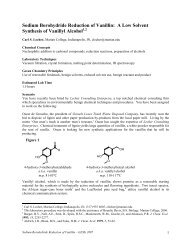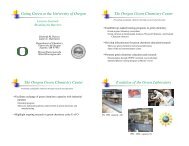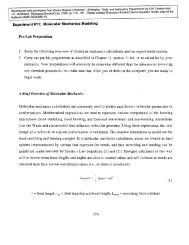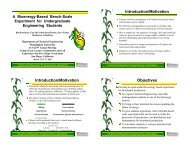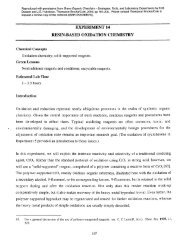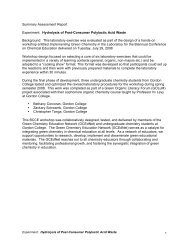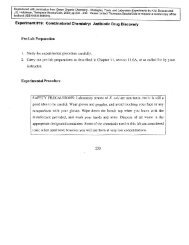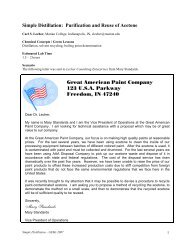Course Syllabus (PDF) - Green Chemistry Center - University of ...
Course Syllabus (PDF) - Green Chemistry Center - University of ...
Course Syllabus (PDF) - Green Chemistry Center - University of ...
- No tags were found...
You also want an ePaper? Increase the reach of your titles
YUMPU automatically turns print PDFs into web optimized ePapers that Google loves.
CALCULATORS: An inexpensive non-programmable scientific calculator without text storage orgraphing capabilities is required for use during quizzes and exams. (For example: Casio fx-115W, TI36X IIS, HP 6S, or Sharp EL-509RB). The calculator you use should have capabilities for squareroots, logarithms, scientific notation operations and an y x key. Inquiries about the acceptability <strong>of</strong>calculators must be made in advance <strong>of</strong> entering the quiz or exam room. Please familiarize yourselfwith your exam calculator before the quiz or exam by using it for homework assignments.The following types <strong>of</strong> calculators are NOT approved for use during quizzes and exams:graphing calculatorpocket organizerhand-held or laptop computerelectronic writing pad or pen input devicecalculator with a QWERTY (typewriter-like) keypadcalculator that makes noises or "talks"calculator that requires an outletcalculator that accepts a "chemistry card"calculator that communicates with other calculatorscell phone calculatorSTUDENT RESOURCESDISABILITY: Any student with a documented disability, who may anticipate needingaccommodations in this course, should arrange to meet with Julie Haack during the first week <strong>of</strong>class. Please request that a counselor at Disability Services send a letter verifying the disability.Disability Services is located in room 164 Oregon Hall and can be reached by e-mail:disabsrv@uoregon.edu, and phone: 346-1155.STUDENT LIFE: If you need help and are not sure where to go check out the Office <strong>of</strong> Student Life.The student life staff is dedicated to helping students have the most successful experience they canwhile studying at the <strong>University</strong> <strong>of</strong> Oregon. The Office <strong>of</strong> Student Life staff is available to help you findsolutions and resources to most issues and concerns on a drop-in basis Monday–Friday, 8:00 a.m.–noon and 1:00–5:00 p.m. In emergencies after hours and on weekends, contact the Department <strong>of</strong>Public Safety at 346-5444 and have an on-duty staff member paged. The Office <strong>of</strong> Student Life islocated in room 164 Oregon Hall; phone: 346-3216; e-mail: stl@uoregon.edu.UNIVERISTY OF OREGON CRISIS CENTER: is a student-funded organization that providesstudents with confidential telephone crisis intervention 24 hours a day, 7 days a week. The hotlinenumber is 346-4488. “Often students believe that their issues are not “severe” enough for them to calla crisis intervention hotline. Here at the Crisis <strong>Center</strong>, we truly believe that there is no problem toosmall for us. At one time or another everyone needs a little help through a difficulty personalsituation.”ACADEMIC DISHONESTYAcademic dishonesty in any guise, including plagiarism, fabrication, and cheating, will not betolerated. All work submitted in this course must be your own and produced exclusively for thiscourse. The use <strong>of</strong> sources (ideas, quotations, paraphrases) must be properly acknowledged anddocumented. Additional information about plagiarism including examples can be found athttp://libweb.uoregon.edu/guides/plagiarism/students/. Consequences <strong>of</strong> academic dishonesty rangefrom receipt <strong>of</strong> a failing grade on the assignment to an F in the course. All violations will be takenseriously and are noted on student disciplinary records. For further information, refer to the studentconduct code at http://studentlife.uoregon.edu/judicial/conduct/code.html.<strong>Chemistry</strong> <strong>of</strong> Sustainability Spring 2009
Lecture Schedule for the <strong>Chemistry</strong> <strong>of</strong> SustainabilityDateWeek #1March 31LecturerHaackHutchisonLecture Topics<strong>Chemistry</strong> <strong>of</strong> Sustainability: Overview and tools<strong>Chemistry</strong> <strong>of</strong> sustainability: <strong>Green</strong> chemistry and life cycle thinkingIntroduction to chemical principles and the properties <strong>of</strong> matterReading Assignment(complete before class)Chapter 1April 2 Haack Classification <strong>of</strong> matter: Composition and atomic structureSustainability: Where do we find starting materials?Chapter 3Week #2<strong>Chemistry</strong> <strong>of</strong> Sustainability: Overview and toolsApril 7 Haack Introduction to molecular design: Bonding and intermolecular forces Chapter 5April 9 Haack Molecular design: How much material do we need and how much is wasted?<strong>Green</strong> chemistry as a set <strong>of</strong> molecular design principlesChapter 6Week #3Chemicals and MaterialsApril 14 Johnson Modern materials: An organic chemistry primer Chapter 9April 16 Tyler Modern Materials: Polymers and plastics Chapter 10Week #4Chemicals and MaterialsApril 21 Tyler Modern materials: <strong>Green</strong> plastics SR #1April 23 Tyler Life cycle assessment and environmental impact SR #2 and 3Week #5EnergyApril 28 Exam #1 Chapters 1, 3, 5, 6, 9, 10 and SR # 1-3April 30 Lonergan An introduction to energy Chapter 14 (14.1 to 14.5)<strong>Chemistry</strong> <strong>of</strong> Sustainability Spring 2009
Lecture Schedule for the <strong>Chemistry</strong> <strong>of</strong> SustainabilityDateWeek #6LecturerLecture TopicsEnergyReading Assignment(complete before class)May 5 Lonergan Fossil fuels and the <strong>Green</strong>house Effect Chapter 12 (12.8 to 12.10 & 12.13)Chapter 14 (14.6 to 14.10)SR #4May 7 Lonergan Bi<strong>of</strong>uels Chapter 15 (15.3 to 15.4)SR #5 and 6Week #7Finishing energy and introducing applications <strong>of</strong> chemistry for the environmentMay 12 Lonergan The potential <strong>of</strong> renewable energy Chapter 14 (14.9 to 14.7)SR #7May 14 Berglund Introduction to biochemistry and enzymes Chapter 15Week #8Applications <strong>of</strong> chemistry for the environmentMay 19 Berglund Using microbes and enzymes to achieve sustainability SR #8May 21 Exam #2 Energy and Biochemistry (chapters 12, 14 and 15 and SR #4-8)Week #9Applications <strong>of</strong> chemistry for the environmentMay 26 Johnson Water: Properties and contamination problems Chapter 13SR #9May 28 Johnson Towards sustainable clean drinking water: Purification strategies and pollutionpreventionWeek #10Applications <strong>of</strong> chemistry for the environmentJune 2 Hutchison Introduction to nanotechnologyJune 4 Hutchison Pollution prevention through nanotechnology and green nanoscienceCertification Scheme Assignment Due at midnight todaySR #10Finals WeekJune 9 Comprehensive final exam (Tuesday) 1:00 pm in room 100 Willamette<strong>Chemistry</strong> <strong>of</strong> Sustainability Spring 2009
Reading List for the <strong>Chemistry</strong> <strong>of</strong> SustainabilitySUPPLEMENTAL READING: Supplemental Readings are available on electronic reserve at the <strong>University</strong> <strong>of</strong> Oregon Library. Thesematerials are accessible 24 hours a day. To access the supplemental readings, select the “<strong>Course</strong> Reserves” tab at the top <strong>of</strong> anylibrary webpage and then search by course title or instructor.SR # Reading Title Source1 The Reemergence <strong>of</strong> Bioplastics Stevens, E. S. <strong>Green</strong> Plastics: An introduction to the new science <strong>of</strong> biodegradableplastics, Princeton <strong>University</strong> Press: Princeton, 2002; pp 104-134.2 Environmental Impact <strong>of</strong> Polymers Scott, G. Polymers and the Environment, Royal Society <strong>of</strong> <strong>Chemistry</strong>: 1999; pp 19-37.3 Design for the Environment: theLife Cycle ApproachAzapagic, A.; Emsley, A.; Hamerton, I. Polymers: the Environment and SustainableDevelopment, J. Wiley: West Sussex, England; Hoboken, N.J, 2003; pp 125-153.4 IPCC FAQs on climate change IPCC, 2007: Climate Change 2007: The Physical Science Basis. Contribution <strong>of</strong> WorkingGroup I to the Fourth Assessment Report <strong>of</strong> the Intergovernmental Panel on ClimateChange; Solomon, S., Qin, D., Manning, M., Chen, Z., Marquis, M., Averyt, K.B., Tignor,M., Miller, H.L., Eds.; Cambridge <strong>University</strong> Press: Cambridge, United Kingdom and NewYork, 2007; pp 93-127.Focus on sections 1.1, 1.2. 1.3, 2.1, 3.1, 8.1, 9.1, and 9.25 Bioenergy Boyle, G. Renewable Energy, 2nd ed.; Oxford <strong>University</strong> Press: USA, 2004; pp 106-146.Focus on sections 4.1 to 4.4, 4.8 to 4.9 and 4.11.<strong>Chemistry</strong> <strong>of</strong> Sustainability Spring 2009
Reading List for the <strong>Chemistry</strong> <strong>of</strong> SustainabilitySR # Reading Title Source6 Point/Counterpoint: The Costs <strong>of</strong>Bi<strong>of</strong>uelsSchulz, W. Chem. Eng. News. 2007, 85, 12-16.7 Powering the Planet Lewis, N.S. Engineering and Science, 2007, 2, 12-23.8 Biocatalysis Thayer, A.M. Chem. Eng. News. 2001, 79, 27-34.9 Science and Technology for WaterPurification in the ComingDecadesShannon, M.A.; Bohn, P.W.; Elimelech, M.; Georgiadis, J.G.; Marinas, B.J.; Mayes, A.M.Nature. 2008, 452, pp. 301-310.10 <strong>Green</strong> Nanoscience McKenzie, L. C; Hutchison, J. E. Chimica oggi (<strong>Chemistry</strong> Today). 2004, 22, pp. 30-33.<strong>Chemistry</strong> <strong>of</strong> Sustainability Spring 2009



